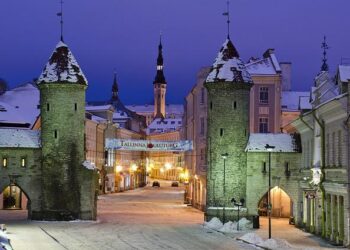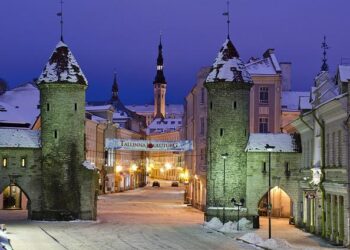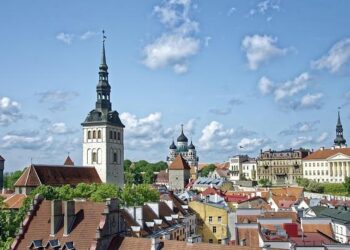Rail Baltic Estonia has officially signed a contract for the construction of the Soodevahe traffic junction, marking the commencement of one of the country’s most complex infrastructure projects to date. This critical development is set to play a key role in integrating Estonia into the broader Rail Baltica corridor, enhancing connectivity and transportation efficiency across the Baltic region. The initiative signals a significant step forward in Estonia’s commitment to modernizing its transport network and strengthening regional cooperation.
Rail Baltic Estonia Commences Construction of Soodevahe Traffic Junction Enhancing Regional Connectivity
Rail Baltic Estonia has officially embarked on the construction of the Soodevahe traffic junction, marking a significant milestone in the country’s largest and most intricate infrastructure endeavor to date. This hub will serve as a critical node, seamlessly integrating the new Rail Baltic high-speed rail line with existing road networks. The project aims to improve traffic flow, reduce congestion, and enhance safety for both freight and passenger transportation across the region.
The contract, recently signed with leading construction firms, outlines a multifaceted approach to engineering and environmental challenges. Key features of the Soodevahe junction include:
- Multi-level interchanges to foster uninterrupted rail and road crossings
- Advanced noise and vibration reduction technologies
- Integration of smart traffic control systems
- Careful environmental impact mitigation measures preserving local ecosystems
| Feature | Impact | Timeline |
|---|---|---|
| High-speed rail integration | Enhances regional mobility | 2024-2027 |
| Environmental safeguards | Protects local wildlife | Continuous |
| Smart traffic systems | Reduces congestion | Implemented by 2026 |
Engineering Challenges and Innovative Solutions in One of Estonia’s Most Complex Infrastructure Projects
The development of the Soodevahe traffic junction presents multifaceted engineering challenges due to its strategic location and the integration of diverse transport modes. Planners and engineers must navigate complex geological conditions, including variable soil density and high groundwater levels, which demand advanced foundation techniques and continuous monitoring to ensure structural stability. Additionally, the junction design must accommodate seamless connections between high-speed rail lines and existing road networks while minimizing disruptions to local traffic and ecosystems.
Innovative solutions are being applied to address these challenges, combining cutting-edge technologies with sustainable construction practices. Key approaches include:
- Advanced soil stabilization methods such as deep soil mixing and jet grouting to provide resilient foundations.
- Modular bridge construction techniques to accelerate assembly and reduce on-site environmental impact.
- Smart traffic management systems to optimize flow during both construction and operational phases.
- Integration of green infrastructure elements to enhance biodiversity and manage stormwater naturally.
| Engineering Aspect | Challenge | Innovative Solution |
|---|---|---|
| Soil Conditions | Variable density and high groundwater | Deep soil mixing & jet grouting |
| Traffic Flow | Interruption during construction | Smart traffic management technology |
| Environmental Impact | Preserving local ecosystems | Green infrastructure integration |
| Structural Assembly | Time constraints and complexity | Modular bridge construction |
Prioritizing Safety and Sustainability in the Development of Soodevahe Traffic Junction
Ensuring the highest standards of safety has been a cornerstone throughout the planning and design phases of the Soodevahe traffic junction. Given its complexity and anticipated traffic volume, advanced engineering solutions are being implemented to minimize risks for both commuters and construction personnel. Technologies such as real-time monitoring systems, reinforced structural elements, and smart traffic management tools will create a resilient infrastructure capable of withstanding dynamic operational demands while prioritizing human safety.
Sustainability measures are equally pivotal in shaping this landmark project. To reduce environmental impact, the construction plan integrates eco-friendly materials, energy-efficient lighting, and green landscaping to enhance biodiversity around the junction. Additionally, efforts to manage runoff water and reduce emissions align with Estonia’s broader goals for climate neutrality. The project team has outlined key sustainability targets, as summarized below:
| Aspect | Objective | Status |
|---|---|---|
| Carbon Emission Reduction | -30% compared to traditional methods | In Progress |
| Use of Recycled Materials | At least 40% of total materials | Planned |
| Stormwater Management | Retention basins and filtration systems | Design Phase |
| Energy-Efficient Lighting | LED with smart controls | Procurement |
Concluding Remarks
The signing of the contract for the construction of the Soodevahe traffic junction marks a pivotal step forward in the Rail Baltic project’s progress through Estonia. As one of the country’s most complex infrastructure undertakings, this development not only demonstrates continued commitment to enhancing regional connectivity but also sets the stage for significant economic and logistical benefits across the Baltic states. Stakeholders will now closely monitor the project’s implementation, which promises to reshape Estonia’s transportation landscape in the years to come.
















